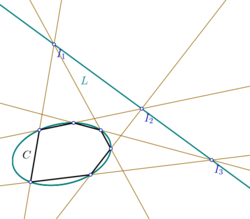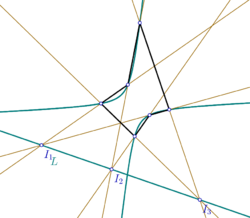Braikenridge–Maclaurin theorem
In geometry, the Braikenridge–Maclaurin theorem, named for 18th century British mathematicians William Braikenridge and Colin Maclaurin,[1] is the converse to Pascal's theorem. It states that if the three intersection points of the three pairs of lines through opposite sides of a hexagon lie on a line L, then the six vertices of the hexagon lie on a conic C; the conic may be degenerate, as in Pappus's theorem.[2]
The Braikenridge–Maclaurin theorem may be applied in the Braikenridge–Maclaurin construction, which is a synthetic construction of the conic defined by five points, by varying the sixth point. Namely, Pascal's theorem states that given six points on a conic (the vertices of a hexagon), the lines defined by opposite sides intersect in three collinear points. This can be reversed to construct the possible locations for a sixth point, given five existing ones.
References
- ↑ Mills, Stella (March 1984), "Note on the Braikenridge-Maclaurin Theorem", Notes and Records of the Royal Society of London (The Royal Society) 38 (2): 235–240, doi:10.1098/rsnr.1984.0014
- ↑ Coxeter, H. S. M.; Greitzer, S. L. (1967), Geometry Revisited, Washington, DC: Mathematical Association of America, p. 76
 |



